Forget About The Moonwatch… The Hand-Wound Omega Speedmaster 57 Has Plenty to Offer!
Because there's more than just one Speedmaster in the collection...
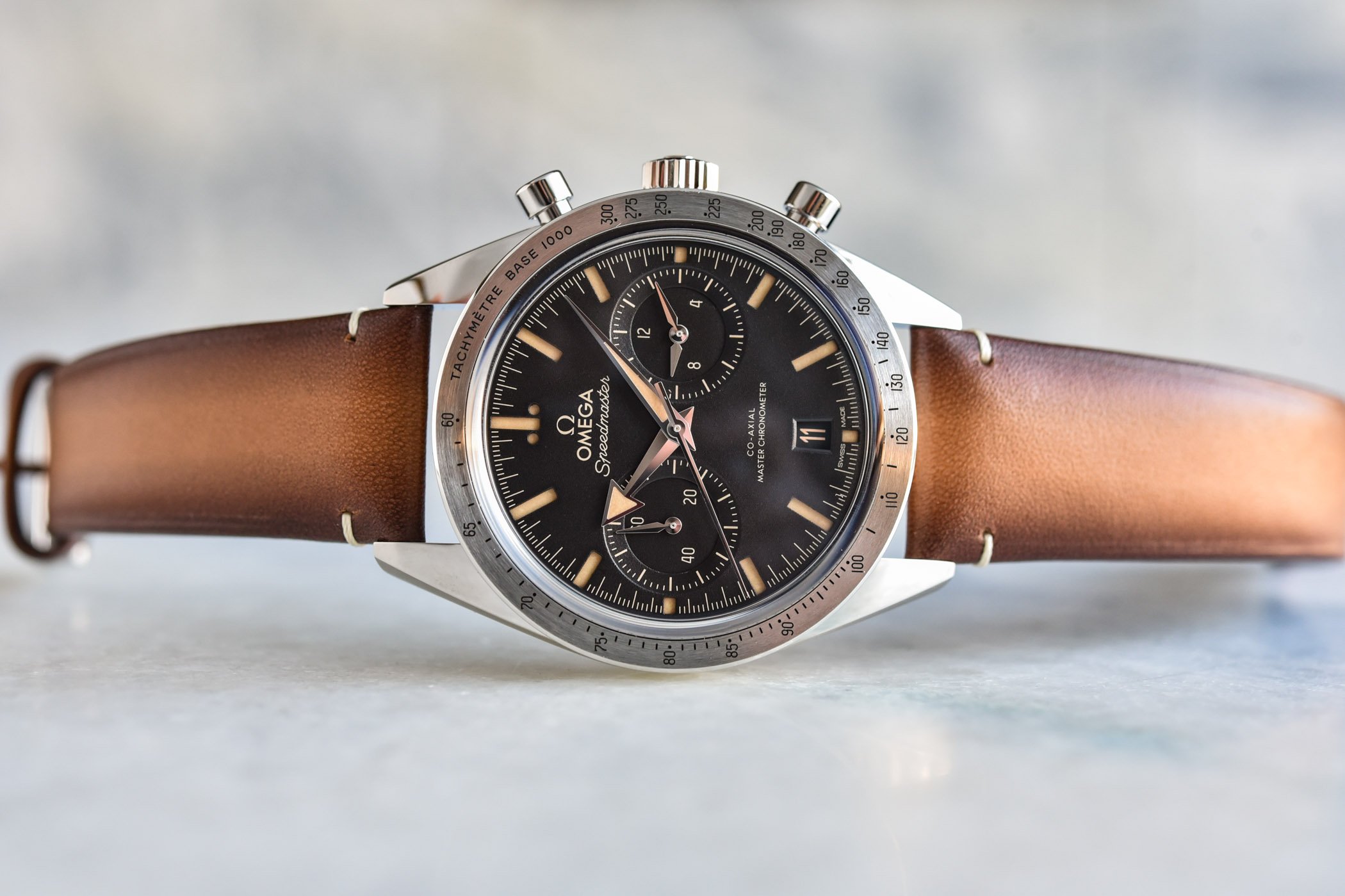
I know… The title is voluntarily a bit provocative. In the world of watches, it’ll be hard to forget about the Speedmaster Professional Moonwatch. It simply is one of the most emblematic and historically-important watches ever made by Omega, and by extension, the whole industry. And the latest version of the Moonwatch, the Master Chronometer Calibre 3861, is one of the best chronographs on the market. Period! However, not everybody will be attracted by this watch. Without denying the qualities of the classic Speedy, there are multiple reasons for someone to prefer something else, something different, something less consensual. Enters the Hand-Wound Omega Speedmaster 57 Chronograph Co-Axial Master Chronometer 40.5mm. And if it has the name Speedmaster printed on its dial, it certainly is a completely different take on the collection and one that has serious arguments too.

For many decades now, the Speedmaster collection has been dominated by the Professional version, also known as the Moonwatch, a watch that has barely changed (design-wise, at least) since the late 1960s and that has become a proper icon over the years. Surely, the specifications have been drastically upgraded recently, with the introduction of the Speedmaster Moonwatch Professional Master Chronometer in early 2021, coinciding with the launch of a brand new movement – finally equipped with a Co-Axial escapement, finally chronometer-rated and now also anti-magnetic. Next to this Speedmaster Moonwatch Professional, there’s long been a collection of watches named Speedmaster too, but not entirely true to the original concept of the space-exploring model. We’ve seen reduced automatic watches in the 1990s, strong design evolutions in the 1970s with the Mark series, or enlarged automatic versions too. But none of them really managed to match the fame of the Moonwatch. Even if virtually unchanged for 50 years and obsolete on some technical levels (at least until 2021), that’s how strong the aura of the Professional model has remained…
However, with all due respect for the Moonwatch, it can’t achieve unanimity. Tastes and colours… There are watch enthusiasts that are simply not attracted by the classic Speedy. Not everybody has to love this watch. Design, looks, and historical background are subjective matters and people react differently to them. Hence why Omega has long created variations around the Speedmaster concept to attract different customers. In this market for the non-Moonwatch Speedmasters, there’s been one interesting watch launched in 2013, the Speedmaster 57.
While the Moonwatch was always powered by a hand-wound movement, there were several different automatic Speedmasters in the collection recently. Some examples are the Speedmaster Racing and its 44.25mm case, and or the previous Speedmaster 57 housed in a 41.5mm case, with the same base automatic, integrated, modern Co-Axial chronograph movement – in different variations, however, with technical differences. If the now-discontinued Automatic Speedmaster 57 was certainly very well equipped, beautifully crafted and overall nicely designed, it somehow failed to convince and remained in the shadows of the Moonwatch. The combination of a larger, thicker case with a contemporary automatic calibre, and on the other side a vintage-inspired design was probably not perfectly balanced. There was room for improvement, and this is exactly the reason why Omega has this year drastically updated the Speedmaster 57 Chronograph.
Smaller, a bit less bulky, more refined, hand-wound… many aspects of the Omega Speedmaster 57 have changed this year, to the point of not being an evolution of the collection, but an entirely new watch. Sure, the look is close to what we’ve seen from 2013 to 2021. But breaking down the specification sheet, you’ll see that not a single part has been kept. Everything is new. And, if I must be honest, everything is now much more attractive. To the point where some potential clients could strongly hesitate between this ’57 and the Moonwatch. Of course, hardcore aficionados won’t be facing this choice and will directly run on the Pro model, but for a more mainstream typology of clients, who could be attracted by some vintage appeal, the competition can definitely exist. And, looking at the Speedmaster 57, there are strong reasons to hesitate.
The Omega Speedmaster 57 in details
As said, the new Omega Speedmaster 57 Chronograph Co-Axial Master Chronometer 40.5mm (yes, that’s its full name) is a strong evolution over the previous model. From a 41.5mm automatic watch, we now moved to a smaller, more compact hand-wound model. What hasn’t changed is the overall inspiration. While the Professional Moonwatch plays on the continuity of the design, being a gradual evolution of a watch that has been in continuous production, the Speed ’57 is an evocation of the past, a typical vintage-inspired model with modern features.
The name says it all. The Speedmaster 57 is modelled after the first ever Speedy, the CK2915-1. The lineage is unmistakable, with its straight lugs and symmetrical case, the brushed steel bezel with black tachymeter scale, the non-protected crown and the dial with broad-arrow hands. The Speedmaster 57 collection, as launched in March this year, comprises 8 references – 4 different dials, available either on steel bracelet or leather strap. Inside this collection, there’s a segmentation to make; 3 colourful dials (blue, green, burgundy) with applied markers and sunray-brushed finishing; 1 black dial with a matte surface and a sandwich construction. We chose the latter for this review, being the most unique and vintage-ish edition.
With this in mind, what you’re looking at is a watch that has lost 1mm in diameter, to now 40.5mm, and with a height of 12.99mm. Not only this is thinner than the previous automatic version by quite a margin (about 3mm less), but it’s also thinner than a classic Moonwatch (about 0.5mm less). One of the major differences between this Speedmaster 57 and the Professional Moonwatch is the shape of the case. No twisted lyre lugs and crown/pusher protective module here. The ’57 is sharp and angular, symmetrical and straight, while the Moonwatch is asymmetrical and presents more curves. The other major difference comes from the bezel. Here, it’s made of steel, is brushed and the tachymeter scale is laser-engraved and then laser-coloured. The brightness of the bezel changes the perception of the watch, compared to the black insert of a Moonwatch.
The combination of a different case shape and a different bezel changes a lot of things on the wrist. While on paper the Omega Speedmaster 57 is thinner and slightly more compact (1.5mm less in diameter), it sits rather differently on the wrist, being more elongated than a Moonwatch that is more packed. The lug-to-lug has been measured at 49.6mm, which is not small, to be honest. A Moonwatch is about 2mm less in this field, specifically since the introduction of the Master Chronometer version. As such, the ’57 sits long on the wrist, while the Moonwatch sits large on the wrist. Then, the brighter bezel tends to add to the presence of the watch, while the black insert of the Moonwatch gives a more compact feel. It’s not really easy to describe on paper, so I can only encourage you to try them both…
In the same vein, the Omega Speedmaster 57 exudes a sheer vintage feel, while the Moonwatch feels more like a timeless object. One is warm, full of charm and slightly more adorned, the other is much colder, more technical, monochromatic and minimalistic. Again, two very different approaches to design, yet within the same range of watches. Retro-styled elements are visible everywhere, on the bezel with DON (dot over ninety), on the box-shaped sapphire crystal, on the bevel on the side of the lugs, on the classic pump pushers… A few specifications to know about the case; push-pull crown, screwed caseback with sapphire crystal and 50m water-resistance. Sufficient for me, but not spectacular either. Overall quality? Well, it’s an Omega, so it’s flawless, ultra-precise, nicely finished, perfectly adjusted, and durable.
The dial is basically following the same direction as the case. Vintage-inspired, but with modern touches. Again, the idea isn’t to be entirely accurate but to evoke the past – if you want something truly accurate, check the 321-powered Moonwatch. As we mentioned above, 4 dials are available. We won’t blame you to be attracted by the cool burgundy or green watches, but for the sake of this article, we thought the black model would be more representative of what the Speedmaster 57 Chronograph Co-Axial Master Chronometer stands for.
In this collection, Omega brings historically relevant elements but also takes some liberties for the sake of vintage charm. As such, you’ll find signature broad-arrow hands, which were only found in the earliest of Speedmasters. Next to this is a so-called sandwich dial, which certainly looks quite brilliant in the metal, even though it has never existed in the past. Here, we have a sand-blasted base with a matte black surface. The markers are not applied or painted but are represented by cutouts, leaving the view on the beige-coated luminous plate underneath. In the same vein, the display isn’t a classic tri-compax but is guided by the movement that sits underneath the dial, a modern architecture with small seconds at 9 o’clock and a single counter at 3 o’clock with hours and minutes. And yes, there’s a date at 6 o’clock… And before we hear you revendicate your rights to the no-date display, keep in mind that this watch isn’t intended for the same population as the Moonwatch. For many potential clients and in various markets, a date complication is still important. Its presence is thus coherent with the rest of the watch.
Inside the case and participating in the new dimensions of this Omega Speedmaster 57 is the calibre 9906, a hand-wound movement partially shared with the recently-presented Chronoscope (another variation around the Speedy theme, with a no-date version of the movement). Based on the automatic 9900, it shows a large ¾ plate on the back with radiating stripes. The architecture is, to the exception of the automatic module removed, the same as before, with a column-wheel and vertical clutch chronograph system, a double-barrel layout used to provide stable torque with 60h power reserve, and a 4Hz frequency to give a precise indication of the elapsed seconds.
Like all modern Omega movements, this hand-wound calibre features a co-axial escapement, is Master Chronometer-certified and is anti-magnetic to impressive levels (15,000 gauss and more…) The decoration is typical Omega, clean and refined, yet due to the large bridge, the movement isn’t very demonstrative. But it really is a big movement in a small case.
This new collection of Speedmaster 57 comes either on a retro-styled brown leather strap closed by a pin buckle or a stainless bracelet. The latter is a so-called “flat-link” that once again evokes the past. Still, its construction is very modern, with nice proportions – 20mm at the lugs, tapering to 15mm at the buckle, with thin links – brushed and polished surfaces, and a folding clasp that features a comfort release with a 2.3mm extension. If there’s nothing wrong with choosing the leather strap, we certainly encourage you to go for the steel bracelet (the difference is 400 euros and justified) and then to choose an aftermarket strap of your choice (or multiple ones). It’s always easier to go in this direction than to buy a steel bracelet from a boutique…
Thoughts
All in all, there’s a lot to love in this Omega Speedmaster 57; a cool retro design, a modern construction, a highly performing movement, smaller proportions, and an overall quality that is simply unquestionable. Now, it’s maybe not a watch for the hardcore Speedmaster fans and will surely attract a different audience. It doesn’t answer the same needs and doesn’t try to play on the same emotions. If hesitation there is between the two, it’ll be rather easy to diffuse the doubts by simply testing them on the wrist. Then, the charm of each model will do its job. Either way, the Speedy 57 is a strong alternative to many great chronograph watches and is a watch with its own personality and strong arguments under the hood. It could be even more compact (quite long lugs and 13mm isn’t particularly thin), but the model has improved over the previous generation.
Availability & Price
The Omega Speedmaster 57 Chronograph Co-Axial Master Chronometer 40.5mm Black dial (reference 332.12.41.51.01.001 on leather strap and 332.10.41.51.01.001 on steel bracelet) is now available and is part of the permanent collection. Prices are EUR 8,700 on leather strap and EUR 9,100 on steel bracelet.
For more details and orders, please visit omegawatches.com.

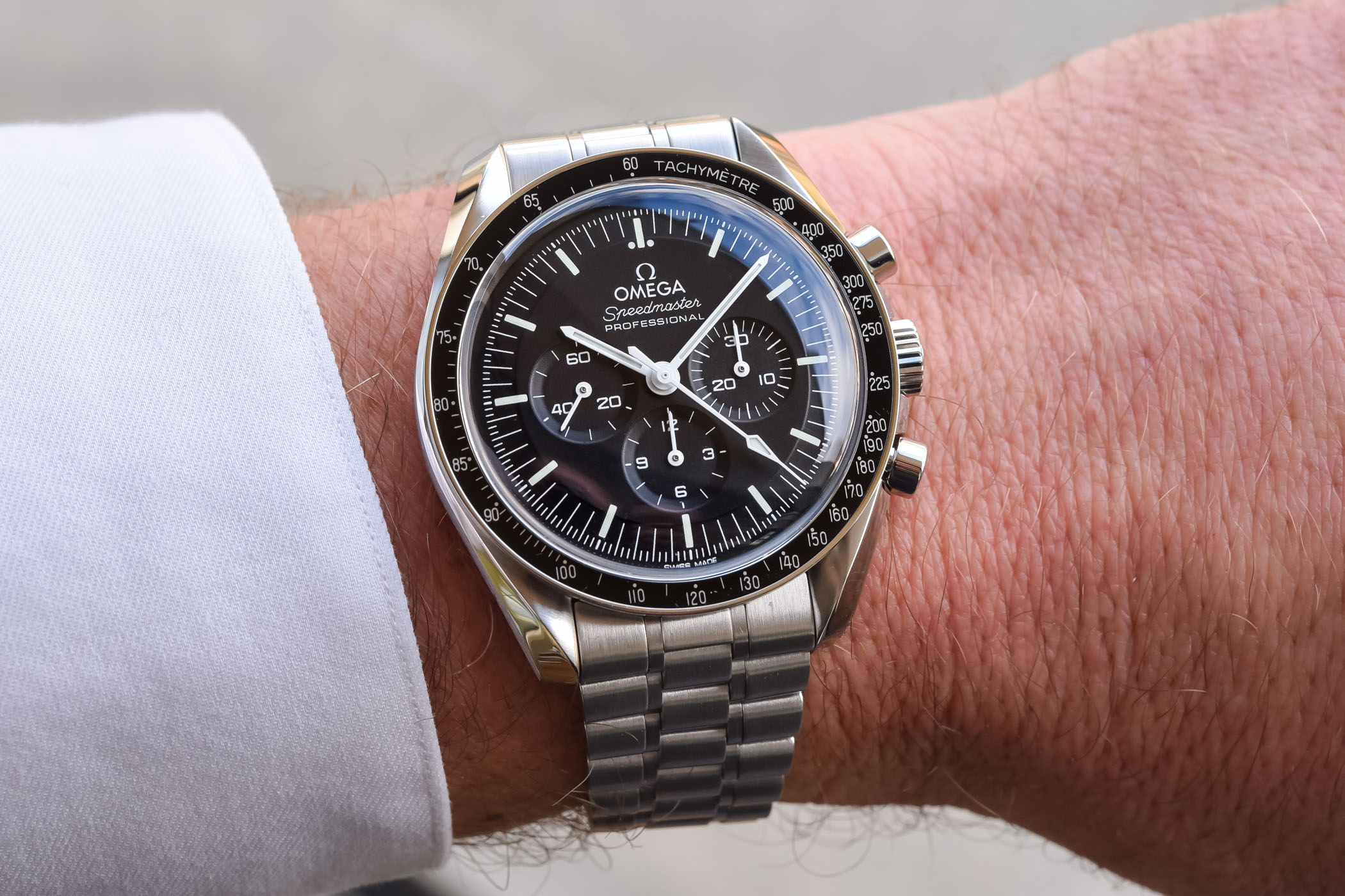


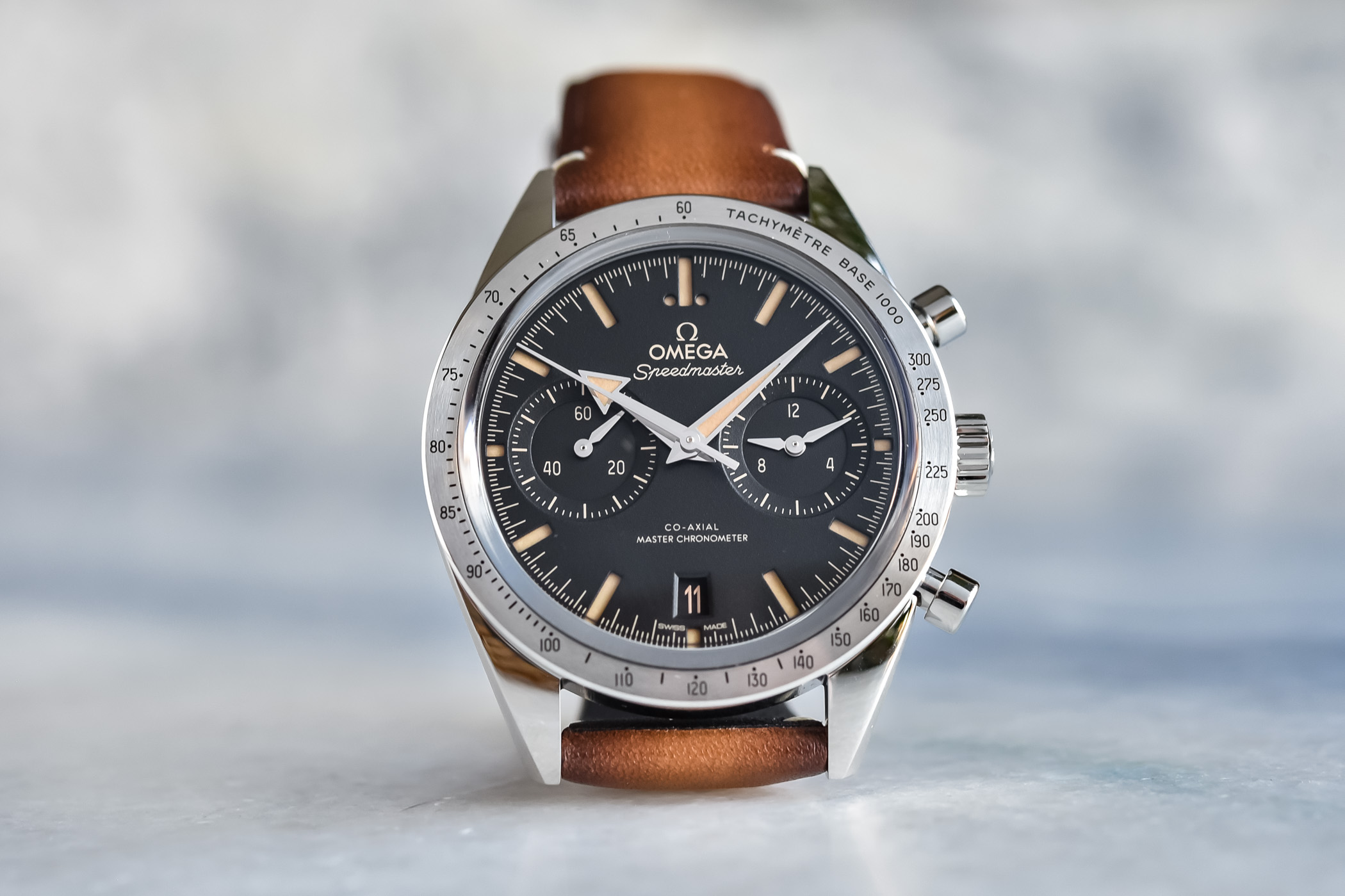
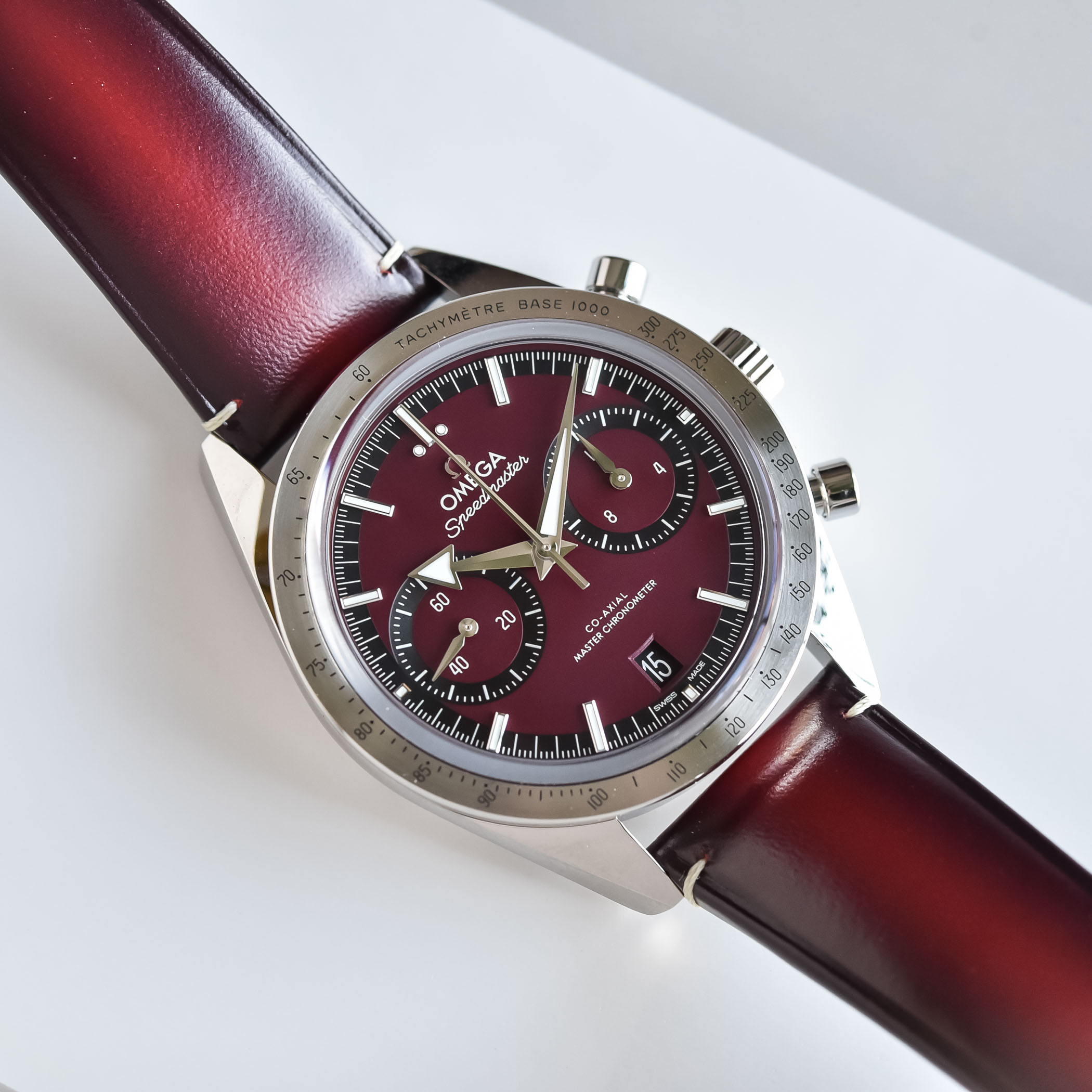
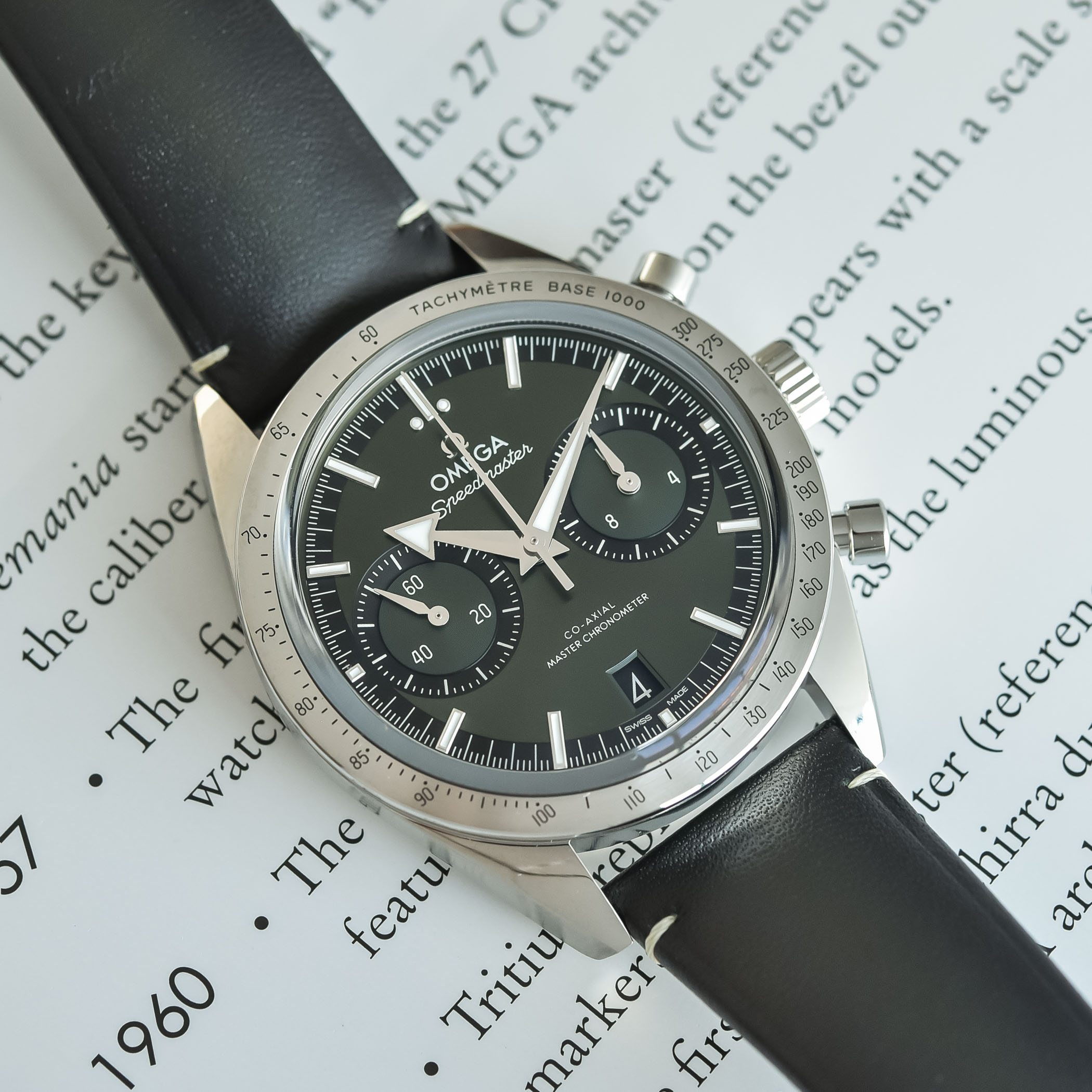
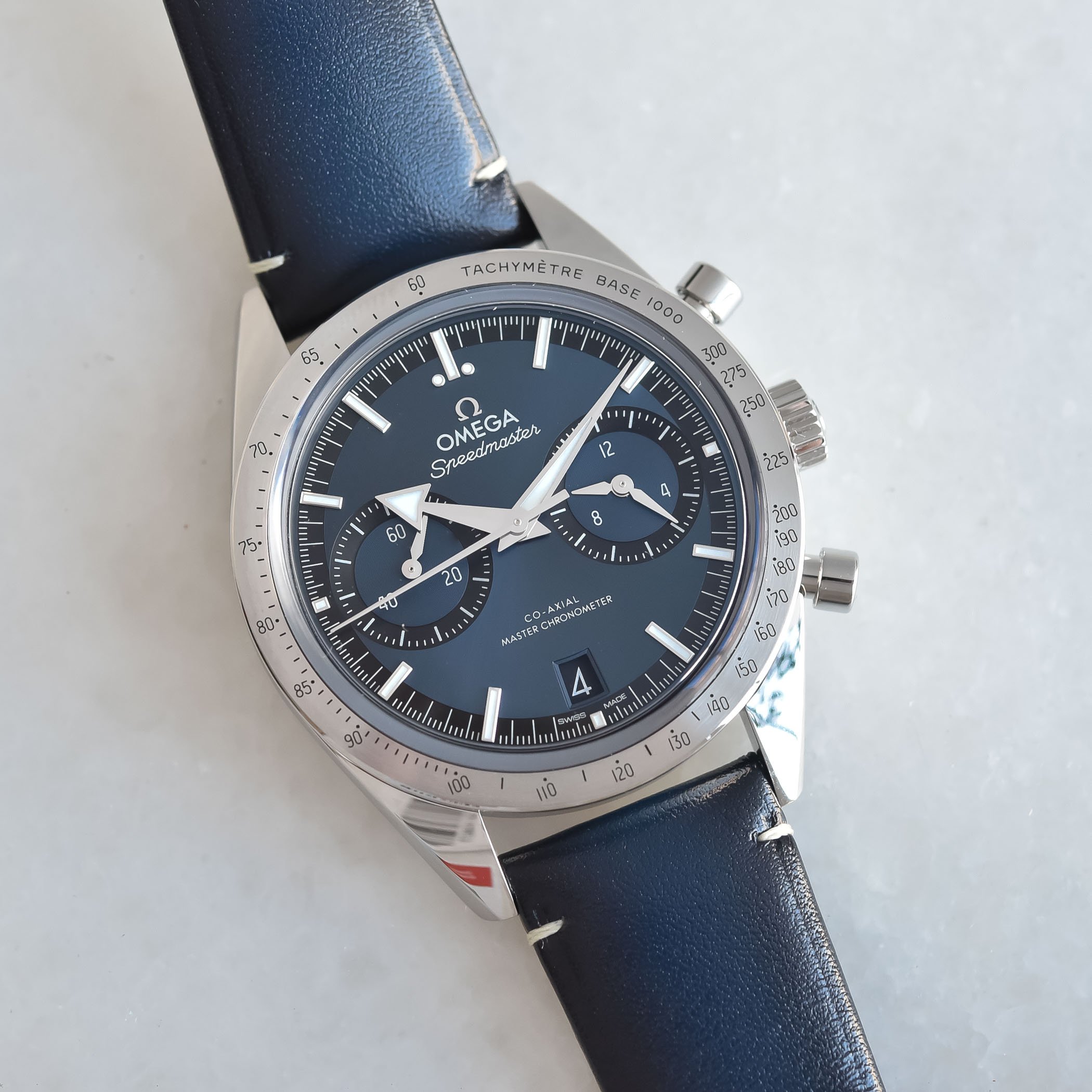






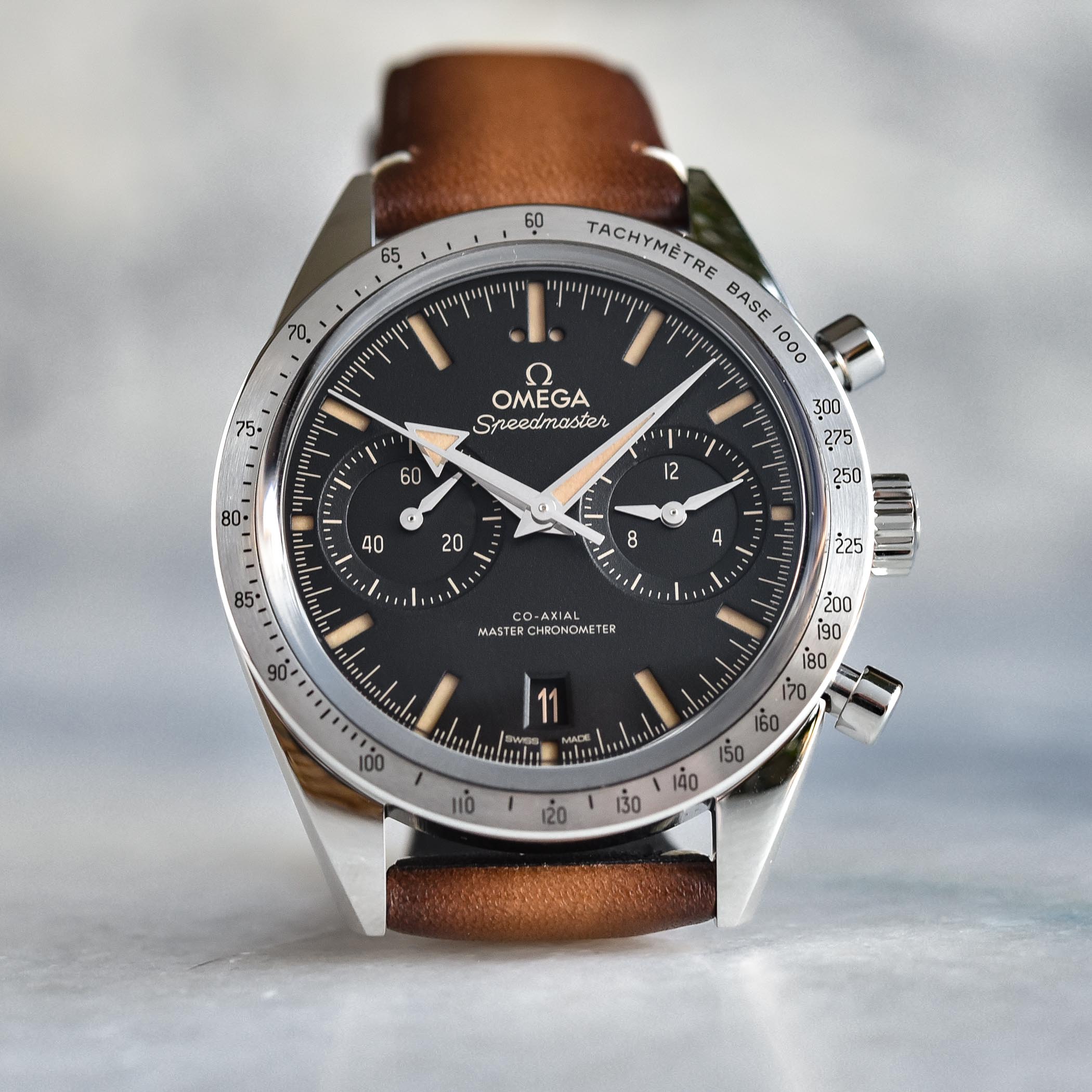
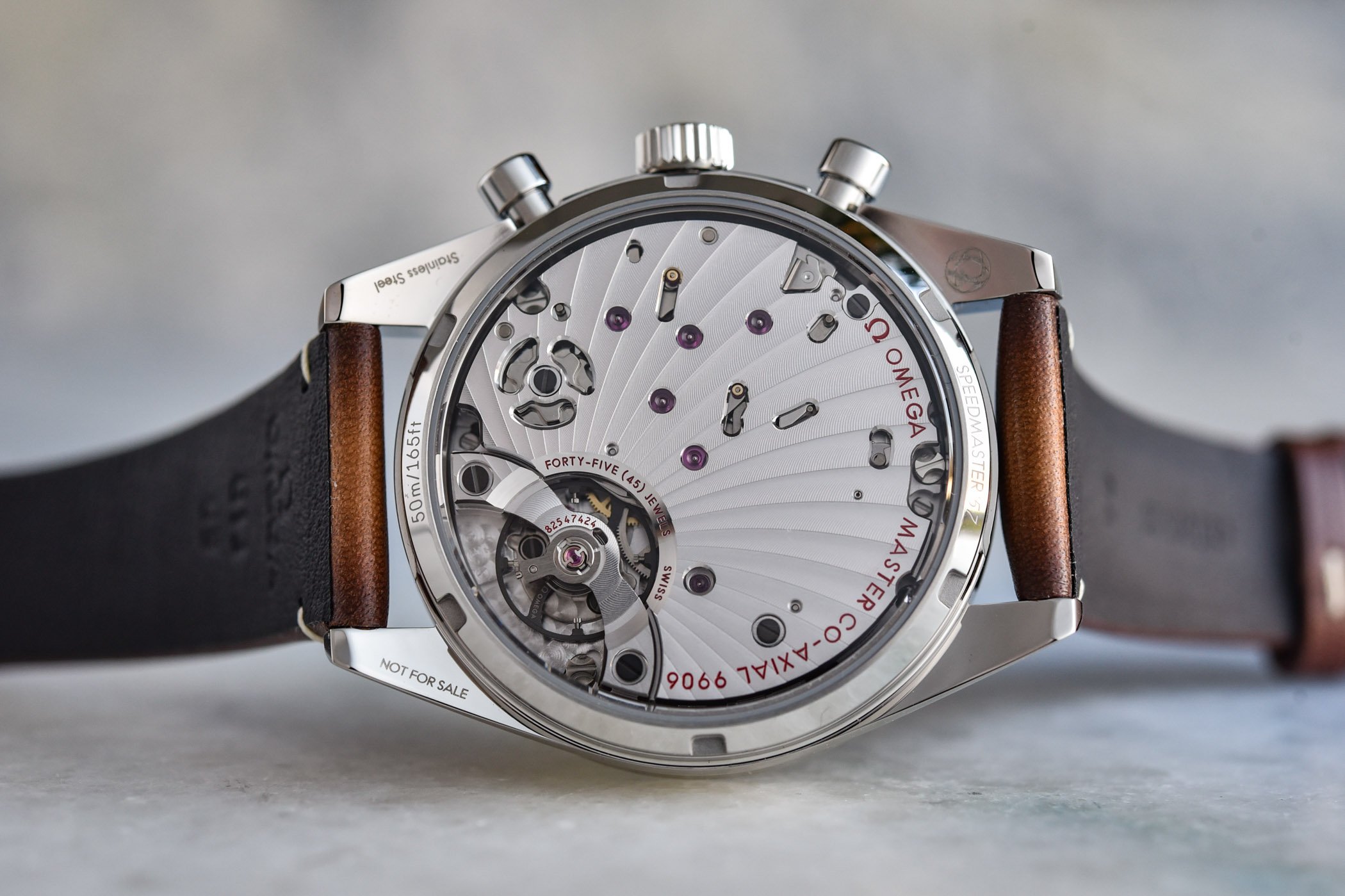









13 responses
Couple of technical points mar what is a very thought provoking article. First, it is said that there are two automatic Speedmaster variants, “the Speedmaster Racing and its 44.25mm case, and then was the Speedmaster 57 housed in a 41.5mm case, with the same automatic, integrated, modern Co-Axial chronograph movement.” Not so, the Racing uses the Cal.9900 Master Chronometer movement and the 41.5mm Speedmaster ‘57 used the Cal.9300 movement, which while related to the Cal.9900 is a less advanced and slightly different predecessor to the Cal.9900. Also there were six automatic Speedmaster ranges, the 38mm, the Mark 2, the Racing, the old 41.5mm ‘57, the ceramic “Sides of the Moon” range and the Moonphase. There are now only four, the 38mm, the ceramic “Sides of the Moon, the Racing and the Moonphase as the old ‘57 and the Mark 2 have been discontinued. Second, the Cal.9906 used in the new Speedmaster’57 is not shared with the Speedmaster Chronoscope as that watch uses a different movement, the Cal.9908, which is the no date version of the Cal.9906.
A step in the right direction but as a tool, the moon watch is much easier to read, the dual hand sub counter makes it almost impossible to quickly tell elapsed minutes and as a chronograph is a little bit of a failure.
I wish it had an automatic movement. A manual winder is a nonstarter for me. I don’t understand why Omega and others struggle to make a think automatic chrono. Rolex, AP and JLC have made a thin automatic Chronograph for years. Seems like most others just take the lazy approach of using a 7750 movement or the thick Omega movements. With Omega’s claim to such engineering prowess the inability for the Swatch group to make a think auto chrono movement in today’s day and age seems strange….
A nice watch for sure, although I don’t dig the pseudo-vintage color scheme. IMO there is no point in putting fauxtina on a dial and then add a date.
Also, it’s hard to argue with the Professional. It’s a great watch, even without the entire moonwatch bla-bla … it’s design is spot-on, striking a perfect balance between funcional and elegant, and the movement is (finally) up to date. IMO, it’s a no-brainer
No quick set date is a failure
@SPQR – thanks for the comment. We’ve changed a few things to make things more clear.
Always fancied a coaxial movement and an omega is the only way I could afford it but they still haven’t managed to build anything I want. Don’t care for chronographs. The only one I could be tempted with is the Seagull 1963, aesthetically pleasing despite being a chronograph.
Nice watch but a hand wound movement with a date function doesnt work for me.
I’m a former NASA employee, and the Moonwatch is my all time number one grail watch, because of the history of becoming an iconic watch. That said, the Speedmaster 57 blows the doors off any of the watches that went to space regarding good looks. It’s is something different, in a very good way. It’s the sheep in wolf’s clothing. If I was going to buy another Speedmaster, it would be this one.
I have just tried one of these at a UK dealer, had to get it in specially… I really wanted to like this, but the lug size made it feel too big. And despite the photos, there is no black lettering on the bezel – just a very faint engraving which is impossible to see. Shame – bought a moonwatch instead.
Handwound yes, date no, coaxial no. I think the watch community, especially websites and youtubers need to seriously look into the failure that is the coaxial. I know it is difficult given that these watches make these websites money, but a failure is a failure. The premise of the coaxial is to reduce the impact of aged oil on the timekeeping of the escapewheel/pallet fork – in this, I suppose it succeeds (haven’t bothered to check given the second point I am going to make), however it does so at the cost of severely worn out escape teeth after only a short period of time (within 5 years); the result is that Omega is forced to change out the entire escapement assembly each time you bring it in for service.
Now a regular lever escapement can be several decades old without showing any wear at all on the escape teeth, however it may have timekeeping affected if the oils wear out. I think I prefer affected timing over worn out escape teeth.
Does this matter to the average wearer who services his watches? Not materially, since you won’t know that all I just said is even happening, which is why the response I usually get whenever I share this are shrugged shoulders. However, a “new invention” that REQUIRES you to switch out parts like a battery does not sit well with me. I don’t like battery powered watches because you HAVE to change the battery otherwise it doesn’t work – you don’t have a choice, even if you hardly wear the watch. A mechanical watch’s charm is that even after 40 years, you don’t really need to service a watch (I know, I have a 40 year old watch that was never serviced) unless the timing goes bad (and you have a water resistance tester to check empirically whether the seals are still good).
Omega DOESN’T need the coaxial. Everything else it does is really really good. It will never abandon coaxial so long as people just keep continually ignoring the issue.
Just bought the green one today. I wasn’t going to buy if the lug to lug was a problem for my 18cm wrist. It wasn’t. Could it be a tad shorter? Yes it can but it does look really good on my wrist regardless. I love the Apollo program and owned Speedmasters throughout my experience as a collector. It was getting less and less wrist time. This case and dial are much more exciting. No disrespect to the MP. It is a wonderful timeless watch. I just don’t like anything sitting around.
@supelativecritic Do you have a source regarding the escape teeth gets severely worn out within 5 years?